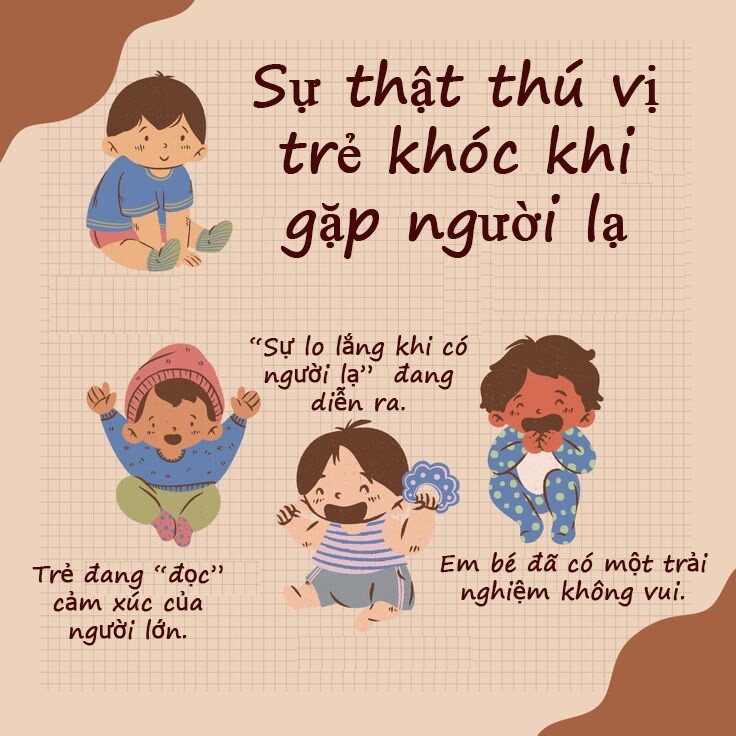Indeed, when a child suddenly exhibits strong resistance towards someone, there may be deeper reasons behind it.


Infants are “reading” adult emotions
Many parents will notice that even though their child cannot yet speak, they are highly sensitive to the emotions of those around them. Infants have an innate ability to absorb the energy and mood of adults, often through eye contact, tone of voice, and body language.
For example, if a mother is anxious about someone (even if she doesn’t show it externally), her baby may sense this subtle emotion and start to reject that person, expressing discomfort by crying, clinging to the mother, or even turning away.

Image source: Pinterest.
Solution
Pay attention to your own reactions: If your child is particularly resistant to someone, refrain from immediately blaming it on “shyness.” Instead, reflect on whether your own attitude towards this person is different. Perhaps you’ve had unpleasant experiences with this individual or unintentionally conveyed negative emotions without realizing it.
Maintain a relaxed atmosphere: Parents can proactively engage in natural communication with each other to signal to the child that “this person is safe.” Converse in a cheerful manner, displaying friendliness and openness.

Your baby is going through “stranger anxiety”
Most children between the ages of 6 months and 2 years will go through a phase of “stranger anxiety.”
During this period, infants will instinctively become cautious of unfamiliar people or environments, sometimes even crying and making a fuss.
Especially when an individual’s appearance, voice, or behavior significantly differs from what the child is accustomed to (such as wearing glasses, having a beard, or speaking loudly), it can easily trigger their fear.
Solution
Don’t force your child to get close: Forcing physical contact or proximity will only increase their anxiety. Instead, observe from a distance and allow them to gradually adjust.
Allow the “stranger” to approach gently: For instance, request that the unfamiliar person refrain from hugging the child directly and instead offer a toy with a smile or engage in casual conversation.

Most infants between 6 months and 2 years old go through a phase of “stranger anxiety.”

Your baby may have had an unpleasant experience
Sometimes, a child’s resistance towards a particular individual has a specific reason. For example, this person may have unintentionally scared the child before (such as by speaking loudly or making abrupt movements), or the child may have had uncomfortable experiences associated with them (such as being forcibly taken away or having their face pinched)
While adults may think “it’s no big deal,” these details are remembered by infants, and they form a conditioned response of opposition.
Solution
Ask questions and observe patiently: If your child can express themselves with simple words, gently inquire, “Why don’t you like this uncle/aunt?” Sometimes, the answer may surprise you, such as “He pinched me hard last time, and it hurt.”
Guide the other person to adjust their interaction style: You can gently remind them, “My child takes time to warm up to new people; let’s take it slow and give them space to get comfortable.”

Your baby may have had an unpleasant experience in the past.
Forcing children to accept people they fear can increase their anxiety and even impact their sense of social safety in the future.
The right approach is to:
– Respect your child’s emotions and avoid coercion.
– Provide guidance and allow them to decide when they are ready to accept the person.
– Refrain from labeling your child as “shy” or “unsociable,” as this may make them more reluctant to interact.
An infant’s reactions are their form of “language.” Crying and resistance are instinctive self-protection mechanisms.
Each cry is an expression of discomfort, a way for the child to communicate with the world, indicating that they are hungry, tired, or in need of comfort and reassurance from their parents.
Therefore, instead of rushing to reprimand them, try to understand the underlying reasons and help your child build a sense of security. Listening and observing will provide insights into their emotions and needs, enabling you to respond appropriately.
Imagine this scenario: if your child feels afraid when encountering a stranger and cries or resists, instead of merely scolding them or demanding that they stop crying, hold them in your arms, reassure them, and explain that there is nothing to be afraid of.
As parents, it’s essential to be patient, listen attentively, and accompany your child on their journey of self-discovery, thereby laying a solid foundation for their holistic development in the future.






























